The Best New York Style Pizza Dough and 14 Tips for Success!!
I’ve been making a lot of this NY style pizza dough recipe …. The obsession started a while back, and I’ve finally found a recipe that I love the best! After years of experiments (and I mean years!), I am now using this recipe based on recommendations from the many fine pizza makers at www.pizzamaking.com and the late great Dough Doctor, Tom Lehmann.

Making Pizza Dough at Home
Making NY style pizza dough is definitely somewhat of an art form. There are so many variables that can be changed aside from the ingredients alone. For example, these variables include:
- oven temperature
- temperature of the water used to make the dough
- proofing methods (room temp vs cold rise)
- order of adding the ingredients (yes, this makes a big difference!)
- mixing time
- use of autolyse
- use of poolish (I don’t do this or the one before, although I have in the past)
And then of course, the toppings which can be simple or as complex as you’d like. But don’t worry too much about all of this – my method is easy and straightforward. Plus, you will make better dough than 99% of the pizza chains out there. You will not want take out anymore!
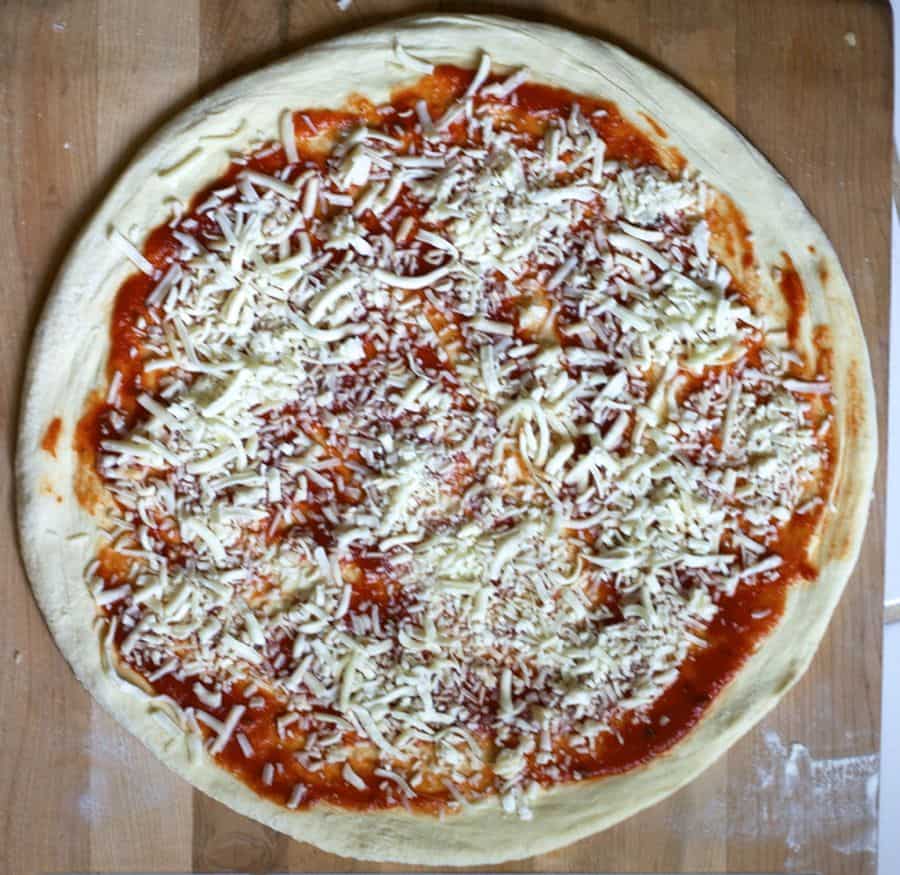
My Favorite Pizza Dough: The Big Secret (How You Proof the Dough)
My all-time favorite dough is NY style dough, which really is classic pizza dough that is stretched out into a thin crust pizza. This type of pizza dough contains water, flour, salt, instant yeast, and olive oil (and sugar especially when baking in a home oven, to help browning).
After it is mixed, it is proofed (left to rise/ferment) in the refrigerator for a minimum of 24 hours and up to 72 hours (it can also be frozen) – this is the big secret. I’ve used the dough up to 5 or 6 days afterwards, so you can essentially prepare dough for the week.
This recipe produces a crisp yet foldable crust that is tender, light, and flavorful and will make enough for four 14-inch pizzas. You can easily double or half the recipe to make 2 or 8 pizzas.

Fourteen Tips for Success
Tip 1: Choosing the flour
Use high-quality flour – I like to use King Arthur’s all purpose or bread flour; higher protein (ie, bread) flours work best. However, I prefer all-purpose flour because I like a lighter, airy crust.
Tip 2: Adding the yeast
Do not add instant dry yeast (IDY) directly to cold or cool water – you may shock the yeast (add the IDY to your flour instead) (please note that IDY differs from active dry yeast, which must be activated by adding it to water).
Tip 3: How much yeast?
Use only enough yeast to “get the job done” – yeast eats the sugar in your flour to produce its leavening effects – I find that if you use too much, your dough will be tasteless (this is just my opinion); however, it is a fact, that too much yeast can make your dough taste bad. Most recipes out there, some of them in well known, published books contain too much yeast!
Tip 4: Cold ferment that pizza dough!
Always use your refrigerator. The best NY style doughs “ferment” or “cure” in the refrigerator for at least 24 hours and up to 48 72 hours. This is called a “cold rise” (vs warm rise on your kitchen counter).
The refrigerator is used to retard (or slow) the dough’s fermentation, allowing that distinctive flavor to come through (ever wonder why some pizza crust tastes different than others, despite the fact that they are both made from just about the same exact ingredients? – this is a big reason why!)
When your dough rises too quickly, the flavor will not develop optimally. Slow rise = MUCH better flavor.
Tip 5: Weigh those ingredients!
Use a scale to weigh the flour instead of using a measuring cup – it is much more accurate and will yield superior results. I’ll admit, I resisted doing this for a loooong time. Just do it. You’ll be glad you did and your dough will be more consistent and much improved.
Tip 6: Add oil last
Mix the oil in as the last step, after the flour has all been incorporated. This is important to allow the flour to hydrate properly.
Tip 7: Flour your dough balls
Before tossing or opening your dough balls, flour them *very* well on each side (if you are a beginner) to ensure they do not stick to your counter or pizza peel. I sometimes use a bit more flour after I begin spreading them.
Tip 8: Keeping those rims a bit puffy
Take care not to “degas” the rim of your pizza as you are spreading your dough! Do NOT ever use a rolling pin! There are many different methods to spread/open your dough ball. I hope to add a few pictures someday of this process.
Tip 9: Baking pizza in a home oven
Ensure that your oven is preheated for a sufficient amount of time (about 1 hour) and bake the pizza within 6 to 8 inches of the top of your oven (ie, your broiler) so that the tops browns sufficiently in conjunction with the bottom of the pizza.
Do not place the stone near the bottom of your oven. I made this mistake for too many years.
After your stone has been preheated sufficiently, the heat from the stone will cook the pizza from the bottom and you can switch the broiler on if you find you need more browning on the top (I now use the broiler to bake my pizzas…more on this sometime in the future).
If you find that your cheese is browning well before your rim attains sufficient color, use partially frozen cheese (ie, place shredded cheese in the freezer while the oven is heating up) and cold sauce or you can drizzle just a bit of olive oil on top of cheese.
Tip 10: Use a pizza stone or steel
Use a pizza stone if you have one. The stone with draw moisture out of the dough and produce a beautifully crisp crust. I use a pizza steel because my stones kept breaking.
Tip 11: Use just the right amount of sauce
Do not use too much pizza sauce – it will make your pizza soggy
Tip 12: Find the right kind of cheese
Do not use low fat cheese to top your pizza or pre-shredded cheese (the former will not melt sufficiently and the latter contains additives that prevent the cheese from sticking together and therefore does not melt very well). The best is low-moisture, whole milk mozzarella.
If you must use pre-shredded cheese, I’ve found that adding the sauce on top of the cheese helps with the melting. Also, do not use too much cheese; apply it sparingly so that you can achieve that mottled NY pizza appearance.
Tip 13: Flour your pizza peel
Use semolina or flour on the bottom of your pizza peel to prevent the pizza dough from sticking but be careful not to overdo it because it will burn.
Tip 14: Learn to launch that pizza
Give the pizza peel a few very small quick jerks to make sure the pizza will easily slide off your pizza peel before attempting to transfer pizza to the oven, and more importantly, rub flour into the peel before placing the dough on top.
Essential Equipment
Please note that as an Amazon affiliate, we earn a small commission if you purchase a product at no additional cost to you.
I adore my baking steel; it’s transformed my home pizzas into restaurant-quality and better. You will love this! A kitchen scale streamlines measurement with remarkable accuracy, while a pizza peel is essential for smoothly sliding pizzas into the oven. And proofing boxes provide an optimal storage for pizza dough fermentation, enhancing flavor, texture, and elasticity.
Please visit our SHOP page for more recommended tools and equipment to make restaurant-style NY-style pizza at home!
How to Stretch the Pizza Dough
A nice video (from The GoodFellas Pizza School of NY), showing how to stretch the dough:

How to Freeze Homemade Pizza Dough
- After mixing dough and dividing into balls, place dough in refrigerator for at least 24 hours.
- Place dough balls on baking sheet lined with plastic wrap or parchment paper, cover loosely with plastic wrap and freeze until firm (~ 2 to 3 hours or up to overnight).
- Wrap frozen dough balls individually in plastic and store in zipper-lock bags for up to 4 weeks.
- When ready to bake, transfer unwrapped dough into the refrigerator for 12 to 24 hours before making pizza.
- Bring dough to room temperature for 20 to 60 minutes before baking (less time for hot kitchen/summer and more time for cool kitchen)
Pizza Dough Calculator
Need more dough? Less dough? Try out our new Pizza Dough Calculator to calculate the weights to get it just right!
Have More Questions?
Please See My NY Pizza FAQ
If you tried this recipe, please leave a 🌟 star rating and let me know how it went in the 📝 comments below! SUBSCRIBE for more recipes.
📖 Recipe

The Best New York Style Pizza Dough
Equipment
- pizza stone or pizza steel for baking
- Standing mixer optional or hand knead
- kitchen scale highly recommended instead of volume measures
Ingredients
Original Recipe for Four 14-Inch Pizzas; want to make more or less? Use the pizza dough calculator
- 6.5 cups (796 g) all purpose flour or bread flour (weighing is most accurate!)
- 2 1/4 cups (493 g) water barely cold water (17.4 oz per 2 1/4 cups)
- 1 teaspoon (3.5 g) instant dry yeast
- 2.5 teaspoons (15.6 g) salt
- 2 teaspoons (7.8 g) sugar
- 1 tablespoon (11.8 g) olive oil
1 Pound of Dough (~454 grams) (use the pizza dough calculator to make more or less dough)
- 2 1/4 cups (274.5 g) all purpose flour or bread flour
- 3/4 cup (170.2 g) water
- 1/2 teaspoon instant dry yeast
- 1 teaspoon salt
- 3/4 teaspoon sugar
- 1 teaspoon olive oil
Instructions
Mixing the Dough
- Place water in mixing bowl.
- In a separate bowl, mix salt and yeast (and sugar if using) into flour
- Combine flour/salt/yeast mixture into water and mix until all the flour has been incorporated.
- After flour has been totally incorporated, add oil and knead for about 4 to 5 minutes (see note)
- Test final dough temperature, which should ideally be between high 70s to low 80s (optional)
Dividing and Rising
- Divide dough into 4 equal pieces (using a digital scale if possible; each ball should weigh 11.5 oz [~326 grams]), shape into a ball, and place in greased, sealed quart-sized container or oiled/greased freezer bag and refrigerate overnight or up to 72 hours (After much experimenting, I have concluded that I like 3 days best but day 2 is good too).
Assembly and Baking
- The following day, remove your dough balls within 1 hour or less of baking and allow the dough to come to room temperature. (the dough will tend to blister more if the dough has not been allowed to come to room temperature however, I often bake coldish dough without problems, just some bubbling)
- In the meantime, place your pizza stone in oven and preheat at 550 degrees (depending on thickness of your stone and your oven’s power) for at least 1 hour
- Open each dough ball using care not to degas, transfer to a pre-floured pizza peel (or on parchment paper), and top with your favorite sauce, cheese, or other toppings.
- Transfer pizza from peel to oven or slide parchment paper onto preheated pizza pan/stone and bake for 4 to 6 minutes each until browned on top and cheese has melted but not burned.
- Enjoy!
Notes
- Use of weight based measurements is highly recommended instead of US Customary. You will need a kitchen scale.
- METRIC amounts DO NOT correspond exactly to the US Customary amounts because, for example, 796 grams equals 6.4 cups (and most can’t measure 0.4 cups or 0.22 cups). Recipe was based on grams.
- Use the Pizza Dough Calculator
- If you want to use the dough the next day, knead a little more (slow speed for about 8 to 10 minutes)
- If you have time to let the dough rest for 3 days, knead for 4 to 5 minutes, low speed or hand knead.
- After mixing dough and dividing into balls, place dough in refrigerator for at least 24 hours.
- Then, place on baking sheet lined with plastic wrap or parchment paper, cover loosely with plastic wrap and freeze until firm (~ 2 to 3 hours or up to overnight).
- Wrap frozen dough balls individually in plastic and store in zipper-lock bags to store for up to 4 weeks (longer may work, but results might vary).
- Before using, transfer unwrapped dough into the refrigerator for 12 to 24 hours before making pizza.
- Bring dough to room temperature for 20 to 60 minutes before baking (less time for hot kitchen/summer and more time for cool kitchen).
- calculate your own using baker’s percentages: 62% hydration, 0.4% yeast, 2% salt, 1.5% oil, and 1% sugar or use my new pizza dough calculator.
Nutrition
Try these other pizzas and this NY pizza sauce:
Buffalo style (one of my absolute favorites)
White with prosciutto
White with spinach and feta
Pizza sauce

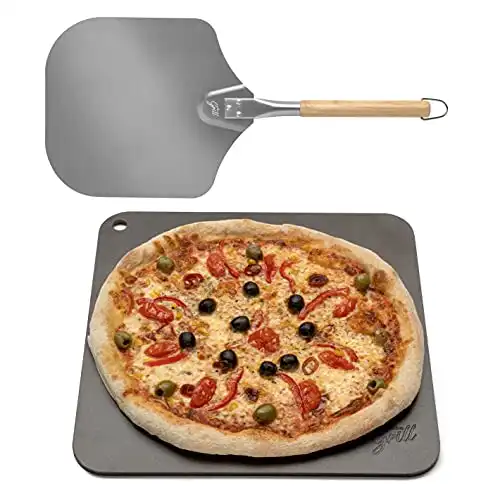
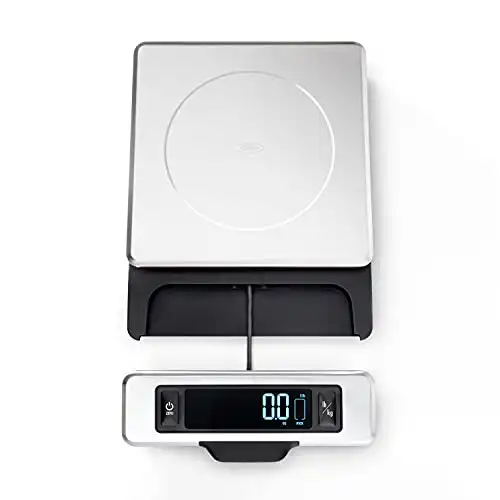
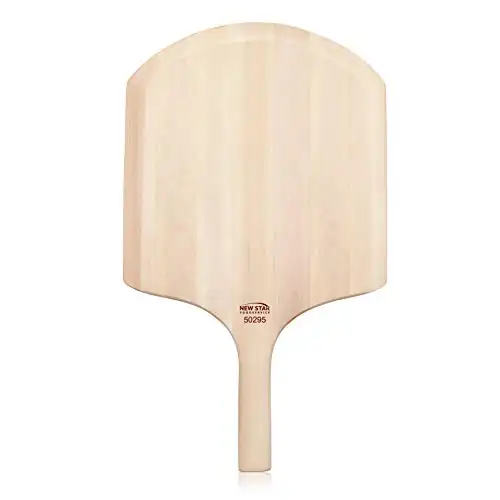
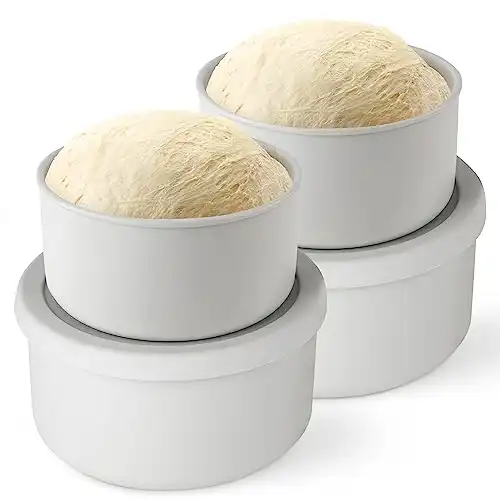
What a world of difference a scale makes just starting back to baking things and did not use my scale and always had problems with the dough but not anymore.
Marie,
Hey, came across your website looking for a good NY dough. I’ve been making pizza at home for 20 years with the family, but have never been happy with my NY crust. I followed all the directions and can already tell there’s something different with this crust. I should have really been measuring my ingredients for all these years. Tonight’s the night and I’ll let you know what the kids think.
Okay, my dough was great! What took me so lone to find a good dough recipe that works? I was looking to get a much thicker end crust and was guessing I’d just split the dough in thirds or halves? Anyone tried doing that?
Hi Reed – it depends on your definition of “thick” – traditional NY pizza is not thick, but you can certainly use this dough to make a good thicker crust pizza (not Chicago style, which is more biscuit-like). You can either make 12 inch pizzas instead of 14 inch to give you a slightly thicker crust and if that’s not thick enough, try dividing dough into 3rds.
Hi Marie, I do not have a pizza stone so my question is will I still use the same temper and cooking time or will it be different.
Looking forward to making this dough today and enjoying it this weekend. Ever tried freezing the dough to use later? Thoughts on whether it will work or not?
Hi Susan – yes, you can freeze it.
Marie,
I too had my dough turn out sticky like Jason did above (May 28th 2013 post) where he ended up using 36oz. of flour rather than your 28oz. I was very careful in using my fairly new scale and tried this recipe twice with the same results. My scale correctly weighs the 17.4oz. of water and all other ingredients, but the 28oz. of flour yields a sticky-stick-to-your-fingers type dough. I understand that flour from the bag can be compacted during shipment, but that does not matter if you are weighing the ingredients, right? I am using King Arthur all purpose unbleached flour. I weighed a cup of flour that I carefully stirred and spooned into a measuring cup and leveled it off gently with a butter knife. This cup weighed 4.63oz. which is pretty close to 4.25oz. taking into account human error. This is really bothering me! I don’t understand why your dough comes out perfect every time when mine comes out sticky when all other ingredients weigh out correctly. I don’t want to, like Jason did, shoot all the way up to 36oz. and compromise your recipe that you worked so hard to perfect. If I keep throwing flour at the problem, am I still going to have a NY pizza dough? Please Help!!!!!
Veronica
I wish I could come over and help you! The first thing that comes to mind, in absence of measuring errors, is that the dough becomes much less sticky as you continue to knead it – are you hand kneading or using a machine? Either way, you can try mixing the flour and water for 2 to 3 minutes and then let it rest for about 10 minutes, then knead again – see if that helps. Otherwise, I’d say knead it a little longer – sometimes what looks like a sticky mess at first ends up really coming together after a few minutes of mixing using a stand mixer.
Email me if you have any other questions! Happy to try and help…marie@feelingfoodish.com
Will this recipe work with Caputo 00? If so, should the flour:water ratio be adjusted, and by how much?
Hi Mike – The Caputo is used for the Neopolitan-style pizzas that are made with only water, flour and salt. I’m sorry but I don’t have much experience cooking those kind of pizzas. Although delicious, they require very high oven temps (600 plus) and my oven only goes to 550 max.
I tried the caputo 00 flour and it worked just fine. I was able to stretch it out just like the guy in the video. I’ve been using Ken Forkish’s recipes (of Flour, Water, Salt, Yeast), which are very tasty and look great, but honestly I think this recipe might be better. This dough is stretchier and just feels better, and it’s easier to make too. I do intend to try regular bread flour next time. I’ll try your sauce recipe next time too. I highly recommend dried marjoram, if not in the sauce, then sprinkled on top. I used fresh mozzarella, because I was used to it from the Neopolitan-style pizzas, but I think the dry version would probably work better on this pizza.
Thanks, Jordan! I’m reading FWSY too, and I’m really enjoying it. I used to make pizza with starter allll the time, and it was really good, but this is so much easier to make, I agree (the starter is very much worthwhile for breads IMO). I’ll try the marjoram sometime – thanks for the tip.
Hi, will try your pizza recipe , yet I do not eat that much pizza at one meal and it is just me. I would like to make a 12 inch pizza but not sure of how to downsize your recipe. Help please thank you.
Hi John – you can use this same recipe but it will be slightly thicker. Still great though!
Thank you Marie, will let you know.
Marie,
Please help me understand the amount of flour. I am using KA flour… Do I use 28oz. or do I use 6.5 cups? Does 28oz = 6.5 cups? Please help! Thanks in advance!
Kerry
Hi Kerry – yes, 28 oz is about 6.5 cups of their all purpose or bread flour. If you’re not using a scale, be careful about how you measure. The flour gets compacted in bags during shipping so you have to stir it and then spoon it into the measuring cup. See here for weights: http://www.kingarthurflour.com/recipe/master-weight-chart.html
Marie,
Thank you for the clarification. I am using a scale and can’t wait until I try this recipe. Do you use KA all purpose or bread flour. Do you have better outcome with one over the over? Thanks!
Marie,
Un******beleivable. Nice crisp base and really nice chew. Crisp but foldable! No more leather dough NY’s for me. Viewers please note, that one of the most imperative steps is to flour both sides really well before opening as mentioned in the video. Also, a sprinkle on the working surface will assure a workable turntable when leveling dough and developing the rim. My dough was slightly sticky before opening and the bath of flour made it really workable. After the dough was stretched and into shape, the dough seemed to have the perfect moisture content. So slightly sticky-not so bad!
Thanks again!
Kerry
So glad you liked it!
I made this last night, and although I didn’t get the stretching quite right, the base tasted awesome!!!!! THANKYOU SOOOOOO MUCH!!! WQill be making again 100%
Nice 🙂
Hi Marie, This article is a masterpiece! It is the best single pizza article I have ever read. I have been making my own pizzas for 1 year and have spent literally hundreds of house scouring pizza forums, doing over 50 trial-and-error pizzas and I have come across most of this information before, in so many different places. This piece pulls it all together in one easy to read, detailed, spot-on at every step instructional, plus you have the perspective of your many personal trial-and-error so you fine tuned everything you learned over the years and shared it with others. I can’t thank you enough. Your recipe is fantastic, it works perfectly for me. The only thing I do differently is that I mix the dough with a food processor per the America’s Test Kitchen NY Pizza method and that works very well. I am still trying to find the best tomatoes and I loved your suggestion to try a different brand every week and that the majority of the flavor comes out of the can. I have been sticking with one brand trying to season it many different ways and was never happy, so your suggestion is excellent.
I have just one question. Previously I have been making cracker thin pizza with the King Arthur sourdough starter and we have enjoyed the flavor very much. I agree that it is a hassle to maintain the starter every week yet every time I go without, it seems lacking. I am relatively new to NY Style, and I was wondering if you could elaborate more about the differences and why you chose the longer ferment time as a substitute. Does that really do the job for you? This is my biggest pizza question at the moment. Thanks again for a brilliant piece.
Hi Tom! I’m so glad that you enjoyed the article on NY pizza. I know what you mean about scouring the net for information. There is such a learning curve to making a good NY dough, so once I succeeded, I wanted to share it with the world! Regarding the starter, it is simply a matter of personal preference. I just got really tired of feeding the starter, etc, and I found that I like the cold ferment dough as much anyway. There are people who cannot do without the starter, and others who would say that a true NY pizza doesn’t need it. So, I leave it up to you. For me, the cold ferment does the trick and adds that bit of flavor that the same day dough definitely lacks. Try doing a 2- or 3-day cold rise if you’ve only done overnight. If it still doesn’t work, maybe try Jeff Varasano’s dough – his uses a starter and he gives very detailed instructions on what to do (Google for more info). And yes, I’ve used the food processor too – only 45 seconds with the special dough blade. Works well! Good luck!
marie,
greetings from here in the philippines, i was looking for pizza recipes coz my bestfriend would like to open a small business, but i didn’t like to copy recipe here in the philippines which is either sweet and sour, or sour and sweet sauce, the dough was always that kind that seems to be just a regular slice bread that is toasted and topped with cheese… i tried your recipe after reading and putting in my heart for about 3 days, i keep scrolling and reading it on, i did the dough yesterday about 10 pm but the next day i was so excited i have to bake the half of the dough hahaha!!!! still it was as perfect as i wanted it to be, so for the next half, i pray that i wont get tempted before the third day comes…. your recommended sauce was absolute perfection, although i was to ask why it was so thick can i thin it down with a little bit of water,but the taste was great …. if you are a boy i will say can i marry you,,, hahaha, my daughter love it so much, i can make pizza now at home so greatful for you, if you are passing by here in the philippines let me know, my home is open for you… love lots emma
What a nice message!! You have totally made my day a happier one:) I’m so glad that the recipe worked for you. Regarding the sauce, yes, definitely add water until it is a nice consistency. I’m sorry if I didn’t make that more clear in the recipe. Happy pizza eating and lots of love right back at you!!
Ok, I tried this recipe twice in the last two days, I used the King Arthurs flour, made the dough exactly like the recipe, used a Sur Le Table pizza steel, etc. I do think this is a very goo recipe, however, we tried stretching the dough just like guy in the video you posted and when we get to the point where he lifts it, it starts to tear in the middle. This happened to us both times, the second time, the dough just kept shrinking back to a smaller size, I finally gave up and made a calzone out of it. any suggestions would be great as we really like the dough, were are just unable to get it to stretch properly.
Hi Tony – did you use bread flour or all purpose flour? It sounds like you had the gluten did not develop properly. Mine has teared if I didn’t mix long enough or if I don’t use bread flour.
Tony, regarding the dough snapping back – try adding another ounce of water next time and/or if you’re only letting the dough sit overnight, give it 2 or 3 days in the fridge. I think you’ll notice a big difference.
I used the king arthur unbleached bread flour, I also used our Kitchen aide to kneed…did it for 5 minutes, maybe I should let it go a little longer ?. On the first try the dough sat in the fridge 24 hours, second try was 48 hours. The second try was better until I tried to lift it like in the video, I should have just left it on the peel because it was pretty good. I will try again next weekend, thank you for the response.
excellent
Having made pizza MANY years ago when my children were residing with us, I was informed by my eldest son that this was an embarrassment to him, but would I please once again make pizza for him!
Then our grandson spent the summer with us and we had three parties with adult guests. They all raved about the pizzas made with this crust. I used NO sauce, but fresh tomatoes, peppers, onion, sausage, etc. for one and Canadian bacon, fresh pineapple, etc. for the other. I have only one stone, thus I used an enamel pan and the crusts turned out well with a parchment paper lining. When inquiry was made regarding the excellent crust, I informed them that it was simple and one guest commented, “It’s like saying the Mona Lisa is just another painting!”
Hi Gale – what a nice complement! I’m so glad the pizza turned out well! 🙂